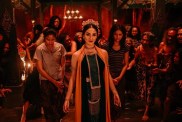Takeshi “Beat” Kitano as Zatoichi
Tadanobu Asano as Gennosuke Hattori
Yui Natsukawa as O-Shino, wife of Gennosuke Hattori
Michiyo Ookusu as O-Ume
Gadarukanaru Taka as Shinkichi
Yuuko Daike as O-Kinu
Daigorô Tachibana as O-Sei/Seitarou
Ittoku Kishibe as Ginzou
Saburo Ishikura as Oogiya
Akira Emoto as Nomiya no Oyaji
Story:
In 19th Century feudal Japan, the nomadic blind masseuse Zatoichi (Kitano) is a man with a secret. Despite his quiet nature, he is a highly trained samurai swordsman, something that helps him when he comes to a small town run by a ruthless gang leader named Ginzou (Ittoku Kishibe). With the help of two “geishas” trying to avenge the murder of their parents, Zatoichi must take down Ginzou and his hired samurai assassin, the equally deadly Hattori.
Analysis:
A popular film genre during the late 50s and 60s, samurai films seem to be in the middle of a major revitalization. On this side of the shores, the genre has received attention thanks to Tarantino’s Kill Bill Vol. 1, which paid homage to the films, but many Japanese directors better known for working in other genres have also begun revisiting the roots of Japenese cinema by making movies set during Japan’s feudal period.
“Beat” Kitano has spent his career making modern-day gangster films, but he takes a big chance by trying to revive one of Japan’s best-known and beloved characters, the star of dozens of serialized films and television shows from 1962 to 1989. Some of those original Zatoichi movies have made it to these shores thanks to IFC’s “Samurai Saturdays”, so the character will not be unknown to fans of the genre, both new and old.
Kitano incorporates some of the storytelling techniques that made the original movies so entertaining like the odd dice game that Zatoichi plays during his spare time in between killings. Still, Kitano doesn’t have nearly as much of the charm or humor that made the character so loveable as played Shintao Katsu for over two decades. Kitano’s Zatoichi is far more ruthless with less of the empathy to the people he encounters on his trips.
The movie seems to be more about those characters though with a lot of the focus being given to the back story of the two “geishas” that travel along the road killing, stealing and trying to get vengeance on those who killed their parents and abused them as kids. (Their “secret” is revealed rather early in the movie but it loses appeal pretty quickly.) Most of the film’s humor comes from a pair of bar owners right out of the original series, and Guadalcanal Taka as the incompetent and overweight samurai wannabe who runs around screaming.
Despite having a good understanding of the character’s popularity, Kitano tries too hard to update the movie for modern audiences by creating a stylish, almost artsy movie, rather than just allowing the movie to bask in the story and characters. Like in most samurai films, Zatoichi’s high points are the beautifully staged and filmed swordfights between the swordsman and dozens of men. Instead of using traditional blood packs to spray blood from those maimed by Zatoichi’s sword, Kitano uses computer-generated blood and body parts to make the gore even more over-the-top. It makes the scenes even more jarring to watch than the old school techniques used by Tarantino in his show stopping Kill Bill swordfight.
As each progressive swordfight gets more elaborate and intense, things seem to be building up to Zatoichi’s final showdown with the gang leader’s bodyguard, but tragically, that moment is a huge letdown, taking place in less than a minute. What could have been a decent story is also ruined by a number of unbelievable back-to-back twists that destroy the very mythos of the character. It’s the type of Hollywood thinking that lessens the impact of Kitano’s version of the character while insulting fans of the original movies.
Probably the dumbest decision by Kitano is to introduce an element that is foreign to the genre tap dancing. Trying to add a bit of art to the violence, Kitano incorporates Japanese tap dance troupe “The Stripes” into a number of scenes. At first, their numbers blend into the background as they portray farmers and carpenters working in time to the hypnotic rhythm of the music. It’s enjoyable in small portions, but Kitano ruins the movie further by having the entire cast-including those that have already died earlier in the film-break out into an extended musical dance number. It’s the type of “what the hell?” moment that loses those who may have been able to withstand the other problems. The synthesizer music used for the soundtrack in place of more traditional music is a lesser distraction, but it is another thing to take the viewer out of the feel of the time period.
The Bottom Line:
Although Zatoichi should act like an introduction to those unfamiliar with the character and genre, it relies far too much on those watching it knowing the original source material. Those who liked Kill Bill may appreciate Kitano’s stylized swordfights, but like Tarantino’s movie, it tends to be more about style than substance. Kitano’s reinterpretation lacks the humor or the humanity of the original films, going against the grain so much that it is a slap in the face to samurai film buffs. Because of this, Zatoichi may be this year’s biggest disappointment so far. Hopefully, other Japanese directors will continue to visit Japan’s feudal period without making such a mockery of what always made the genre so entertaining.










